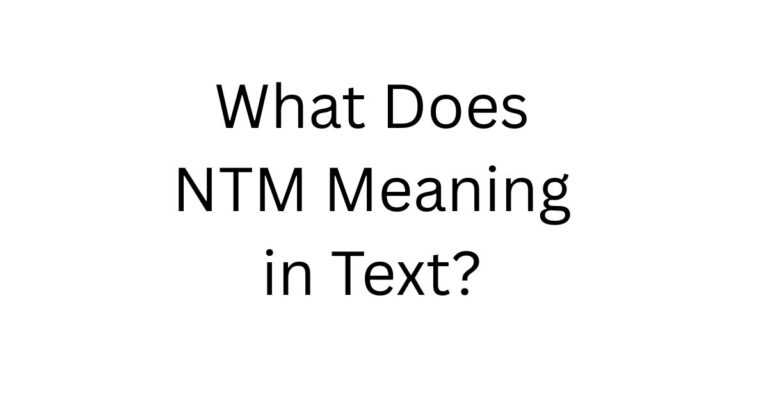In today’s digital world, where text messages, social media, and chats dominate how we connect, short forms like NTM have become part of daily communication. From my own experience managing online communities, I’ve seen how people rely on abbreviations and acronyms to save time and express thoughts more efficiently. The acronym NTM often shows up in informal and semi-formal online conversations, usually meaning “Not Too Much.” It might seem small, but using such short terms in the right context and tone really improves how natural the phrase feels in digital spaces.
That said, it’s not just about knowing the meaning. Depending on the formality of the chat—be it a casual group chat or a professional thread—understanding when it’s appropriate to use NTM can shape the flow of your communication. I’ve found that having alternative expressions based on the intention behind your message can help you sound more respectful or relaxed, depending on the situation. With over 13 great alternatives, choosing the right one depends on how polite or direct you want to be. Mastering these choices lets you express yourself smoothly while keeping things clear and friendly.
NTM Mean in Text
How NTM Is Used in Everyday Chat
When someone asks simple, open-ended questions like “what’s up” or “how’s it going” in casual, online chats or text messages, it’s common to see NTM in the reply. It’s a common acronym that stands for “Not Too Much,” often used as a short, chill answer. I’ve seen this a lot while texting friends—someone asks, “what are you doing?” and the reply is something like “NTM, just chilling” or “NTM, you?” It’s quick, easy, and keeps the convo going.
From my own chats, I can tell you NTM is a low-effort way to give a neutral response when the sender isn’t currently doing anything significant or particularly interesting. It’s the perfect space-filler that says, “I’m around, but not much is going on.” Using NTM this way helps keep things light and informal, which is often the goal in relaxed texting.
When NTM Feels Too Casual
The phrase NTM is naturally informal and fits best in social media conversations or while texting friends and acquaintances. It’s shorthand, a bit unpolished and relaxed, making it perfect for chill talk but clearly not made for serious settings. From my texting habits, I can say using NTM adds a laid-back vibe that works only in a casual space.
However, in professional or formal communication, throwing in NTM might come off as lazy, hurting your credibility and showing a lack of attentiveness. In business settings, job interview replies, academic discussion, or email threads, choosing more polished alternatives is simply the wise thing to use. You want to sound clear, capable, and intentional, not overly laid-back when it matters most.
Why Tone Changes Everything
Language isn’t just about words—it’s also about tone, context, and how deep your relationship with the other person runs. From personal experience, replying with something like “not too much” may seem simple, but it often reveals your familiarity with the person, your professionalism, or even your emotional intelligence. In fact, how you respond with that kind of phrase (or its alternatives) can easily reflect your level of social awareness.
That’s why choosing the right tone at the right time matters. If you really understanding how to switch things up depending on the situation, your communication naturally improves in both personal and professional settings. I’ve noticed this firsthand—being thoughtful about tone has consistently boosted the effectiveness of my interactions, whether I’m keeping things chill or aiming to sound more polished.
Top Alternatives to Use Instead of “NTM”
When texting friends, acquaintances, or chatting on social media, choosing the right phrase can add more color than simply replying with “NTM” (Not Too Much). I’ve often replied with “just chilling” or “taking a breather” when I want to sound relaxed but still present. These kinds of casual options offer a soft tone that feels easy and familiar, perfect for downtime chats or uneventful days. Expressions like “same old, same old” or “not much going on today” feel routine and clear, yet they’re far more engaging than the generic NTM.
If you’re looking for something a bit more neutral, expressions like “keeping things low-key,” or “nothing major, just catching up on things” give off a modern and straightforward tone without sounding dry. I’ve used “just relaxing and recharging” especially after a long day—it gives off that warm self-care vibe while still sounding natural. These small switches reflect both your emotional state and show a little more depth in everyday conversations.
In slightly more professional or semi-formal settings, like when chatting with a colleague, options like “just the usual work grind” or “not a lot on my plate at the moment” are great. I’ve often used these during check-ins with team members—it keeps the tone light but still acknowledges deadlines and tasks. Saying “things are pretty calm today” or “everything’s running smoothly, thankfully” adds a polite and optimistic edge, especially when talking through daily updates or project pacing.
Finally, for versatile moments, I sometimes go with “it’s been a quiet one.” It carries a thoughtful, almost reflective vibe that works in various contexts—from personal chats to more mellow workplace exchanges. Knowing these 13 well-placed alternatives improves your communication, reflects your emotional intelligence, and keeps you tuned in to the tone and pace of your conversation.
When You Should Avoid Using “NTM”
While NTM is commonly used in texting, I’ve learned over time that it’s not always the best choice—especially in more serious settings. In professional spaces, it often feels too casual and even a little disengaged. I remember once replying with “NTM” during a team message, and it honestly felt out of place. It lacked the effort you’d expect in a work environment.
In formal messages or emails, using NTM can come off as lazy or even dismissive, which may leave the wrong impression. I’ve also noticed that when talking to older generations, phrases like this can be misunderstood or feel unclear—they might not get what you mean. Similarly, in customer service interactions, saying “NTM” might fail to convey the warmth or helpfulness people are looking for. In all these situations, it’s better to go with clear, descriptive phrases that show real attentiveness and effort.
Tone Really Does Matter in What You Say
Understanding that tone truly matters has changed the way I approach texting and digital conversations. Whether you’re trying to sound casual, neutral, or professional, picking the best alternatives to something like “NTM” helps you come across more clearly. I’ve found myself naturally leaning into phrases like “just taking it easy” or “same old” when I want to keep things light and friendly—these expressions feel effortless but still personal.
On the flip side, if the moment calls for a neutral tone, I’ll often go with something like “not much going on” or “quiet one.” These phrases offer a balance that sits well in group chats or informal updates. When I’m at work, though, it’s all about sounding on-point without overdoing it—phrases like “running smoothly” or “work grind” keep things sharp but still human.
By tailoring your language to the relationship and platform, you naturally build stronger trust and connection. Lazy acronyms like “NTM” often fall short—they lack the depth and intention needed to really achieve a solid impression. Whether you’re chatting for fun or professionally, how you express yourself truly shapes the outcome.
The Power of Expressive Simplicity
What I’ve come to appreciate most is the beauty in replacing “NTM” with something more thoughtful. It’s not about being wordier or adding complexity—it’s about choosing words with tone, emotion, and engagement. Whether I’m telling a friend I’m available to chat or simply sharing a slice of my day with a coworker, picking well-matched language makes all the difference.
These small choices carry the real power of expressive simplicity. They don’t just fill space—they strengthen your communication across every setting, making each message more genuine and human.
Conclusion
While “NTM” might be quick and easy, it often lacks the depth and clarity that real connection demands. By choosing more expressive, thoughtful, and tone-aware alternatives, you not only improve your communication but also build stronger relationships—whether you’re chatting with a friend, replying to a coworker, or navigating different settings. In the end, how you say something matters just as much as what you say.
Read More: 1000+ Ultimate Gaming Names to Boost Your Game Today

JCK Smith is a seasoned writer specializing in the names niche, helping individuals and businesses find the perfect names for groups, teams, brands, and more. With years of experience in creative naming, JCK blends originality with strategic SEO to craft lists that rank high on search engines and provide real value to users.











